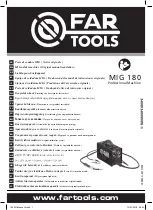
IMS GOLD MULTI 140
Translation of the original instructions
EN
15
Welding area assessment
Before installing the machine, the user must evaluate the possible electromagnetic problems that may arise in
the area where the installation is planned, in particular, it should consider the following:
a. Other cables, control cables, telephone cables: above, below and besides the device;
b. TV and radio receivers/transmitters ;
c. Computers and other control equipments ;
d. Essential safety equipment such as security controls for industrial equipment;
e. the health of people who are near the device, such as people who wear a pacemaker, a hearing aid, etc ...;
f. Equipment used to calibrate and measure ;
g. The resistance of the other devices installed in the area of use of the device. The user will have to make sure
that the devices in the same room are compatible with each other. This may require additional precautions;
h. The time of day during which the unit must operate;
The surface of the area to be considered around the device depends on the the building’s structure and other
activities that take place there. The considered area can be larger than the limits fixed by the companies.
Welding area assessment
Besides the welding area, the assessment of the arc welding systems intallation itself can be used to identify and
resolve cases of disturbances. The assessment of emissions must include in situ measurements as specified in
Article 10 of CISPR 11: 2009. In situ measurements can also be used to confirm the effectiveness of mitigation
measures.
RECOMMENDATION ON METHODS OF ELECTROMAGNETIC EMISSIONS REDUCTION
a. National power grid:
The arc welding machine must be connected to the national power grid in accordance
with the manufacturer’s recommendation. If interferences occur, it may be necessary to take additional preventive
measures such as the filtering of the power suplly network. Consideration should be given to shielding the power
supply cable in a metal conduit. It is necessary to ensure the shielding’s electrical continuity along the cable’s
entire length. The shielding should be connected to the welding current’s source to ensure good electrical contact
between the conduct and the casing of the welding current source.
b. Maintenance of the arc welding equipment:
The arc welding machine should be be submitted to a
routine maintenance check according to the manufacturer’s recommendations. All accesses, service doors and
covers should be closed and properly locked when the arc welding equipment is on.. The arc welding equipment
must not be modified in any way, except for the changes and settings outlined in the manufacturer’s instructions.
The spark gap of the arc start and arc stabilization devices must be adjusted and maintained according to the
manufacturer’s recommendations.
c. Welding cables:
Cables must be as short as possible, close to each other and close to rhe ground, if not on
the groud.
d. Electrical bonding :
consideration shoud be given to bonding all metal objects in the surrounding area.
However, metal objects connected to the workpiece increase the riskof electric shock if the operator touches
both these metal elements and the electrode. It is necessary to insulate the operator from such metal objects.
e. Earthing of the welded part :
When the part is not earthed because for electrical safety reasons or because
of its size and its location (which is the case with ship hulls or metallic building structures), the earthing of
the part can, in some cases but not systematically, reduce emissions. It is preferable to avoid the earthing of
parts that could increase the risk of injury to the users or damage other electrical equipments. If necessary,
it is appropriate that the earthing of the part is done directly, but in some countries that do not allow such a
direct connection, it is appropriate that the connection is made with a capacitor selected according to national
regulations.
f. Protection and plating :
The selective protection and plating of other cables and devices in the area can
reduce perturbation issues. The protection of the entire welding area can be considered for specific situations.
















































